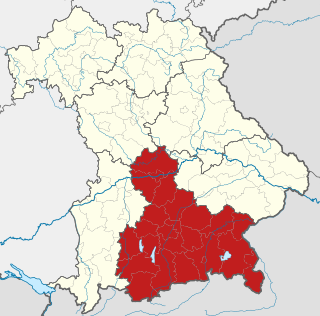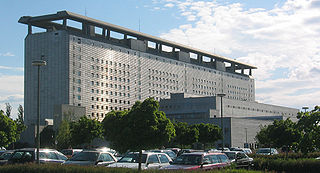

Hadern is the 20th borough of the Bavarian city of Munich in Germany.


Hadern is the 20th borough of the Bavarian city of Munich in Germany.
Located in the south-west of Munich, Hadern's borders are the Autobahn Munich-Garmish in the south, Fürstenriederstrasse in the east and Senftenauerstrasse in the north and also the south. A large part of the borough is occupied by the Waldfriedhof, the largest cemetery in the city.
Hadern was originally a farmer village and was first mentioned in the 11th century by the name of Haderun. Großhadern belonged to the Benediktbeuern Abbey, Kleinhadern to the Schäftlarn Abbey. Großhadern was incorporated into Munich in 1938, thus making it the youngest district. The structures of the former rural settlement in Großhadern can still clearly be made out in the old village centre. Structurally, Hadern consists mainly of family homes. On areas previously used for agricultural purposes in the district, large living complexes like the Blumenau or the complexes on Senftenauerstrasse and in Neuhadern with a high proportion of council tenants were built after the Second World War until into the 80s.
New residential buildings are currently being built south of the Klinikum Großhadern. Since the extension of U-Bahn Line 6 to the clinic, the district is well connected in terms of public transport.
The Klinikum Großhadern (Großhadern Medical Centre) of the Ludwig Maximilian University of Munich is the largest hospital complex in Munich. In 1994 the Genzentrum (Gene Centre) of the LMU was put into operation and in 1999 the entire chemical/pharmaceutical faculty was relocated to Hadern. Further constructional development followed in 2004 with the inclusion of the lecture and research department in Department Biologie II of the Biozentrums der HighTech CampusLMU (Biology Centre of the HighTech CampusLMU). Over the mid and long term the entire biological faculty and further science faculties and institutes are to be consolidated together here.
The Kinderzentrum des Bezirks Oberbayern (Children's centre of Oberbayern) and the associated Montessorischule as well as the Augustinum elderly home [1] in the area and its associated Stiftsklinik are further social facilities located in the district, that along with the clinical centre, constitute the majority of available jobs in the area.
The social order of the population consists of young people, workers as well as elderly people, above all in residential buildings and homes for one family. The proportion of foreigners in Hadern is under the city average.
(As of 31 December, inhabitants with principal residence.)
| Year | Inhabitants. | of which Foreigners | Area ha. | Residents per ha. | Source |
|---|---|---|---|---|---|
| 2000 | 41,689 | 7,526 (18.1%) | 921.59 | 45 | Statistisches Taschenbuch München 2001. pdf-Download |
| 2001 | 41,858 | 7,614 (18.2%) | 921.59 | 45 | Statistisches Taschenbuch München 2002. pdf-Download |
| 2002 | 42,563 | 8,051 (18.9%) | 921.59 | 46 | Statistisches Taschenbuch München 2003. pdf-Download |
| 2003 | 42,823 | 8,364 (19.5%) | 922.55 | 46 | Statistisches Taschenbuch München 2004. pdf-Download |
| 2004 | 43,396 | 8,683 (20.0%) | 922.55 | 47 | Statistisches Taschenbuch München 2005. pdf-Download |
| 2005 | 43,981 | 9,024 (20.5%) | 922.37 | 48 | Statistisches Taschenbuch München 2006. pdf-Download |
(Statistical Pocket Book of Munich)

Upper Bavaria is one of the seven administrative regions of Bavaria, Germany.

The Ludwig Maximilian University of Munich is a public research university in Munich, Bavaria, Germany. Originally established as the University of Ingolstadt in 1472 by Duke Ludwig IX of Bavaria-Landshut, it is Germany's sixth-oldest university in continuous operation.

Garching bei München or Garching is a city in Bavaria, near Munich. It is the home of several research institutes and university departments, located at Campus Garching.
The Munich U-Bahn is an electric rail rapid transit network in Munich, Germany. The system began operation in 1971, and is operated by the municipally owned Münchner Verkehrsgesellschaft. The network is integrated into the Münchner Verkehrs- und Tarifverbund and interconnected with the Munich S-Bahn. The U-Bahn currently comprises eight lines, serving 96 stations, and encompassing 103.1 kilometres (64.1 mi) of routes.

Martinsried is a village in the municipality of Planegg in Munich district, Bavaria, Germany. It is one of Munich's two science suburbs.

Au-Haidhausen is the 5th borough of the German city of Munich, Bavaria. It is formed by the Au and Haidhausen districts.

Thalkirchen-Obersendling-Forstenried-Fürstenried-Solln is the 19th borough of Munich, Germany, comprising the extreme southern part of the city on the west bank of the river Isar. After the administrative reform, the boroughs Thalkirchen-Obersendling-Forstenried and Solln were incorporated, thus forming the new borough. It comprises 17.7631 square kilometres and has a population of 96,714 residents.

Untergiesing-Harlaching is the 18th borough of Munich, Germany, mostly the districts of Untergiesing and Harlaching. The borough's western border is the river Isar, in the south it borders on Grünwald and the Perlacher Forst [German-language Wiki: Perlacher Forst], to the north-west on the Munich borough of Obergiesing and to the north on the borough of Au-Haidhausen.
Gabersee is a borough of the town Wasserburg am Inn in Bavaria in Germany. Gabersee was the site of a post World War II American sector displaced person camp. It is the birthplace of Carl Troll, and home to a psychiatric hospital, where Friedrich Ludwig died in 1970.

Helmholtz Zentrum München Deutsches Forschungszentrum für Gesundheit und Umwelt (GmbH), also known as Helmholtz Munich, is a member of the Helmholtz Association of German Research Centres. It was founded in 1960 and is a joint venture by the Federal Ministry of Education and Research and Bavarian State Ministry of Finance and Home.

The McGraw Kaserne is a former military installation in southern Munich, Germany, which was used by the U.S. Military during the occupation of Germany after World War II. The main building was one of the first ones in Germany to be built using steel frame technology. The kaserne was named after PFC Francis X. McGraw.

Ludwigsvorstadt-Isarvorstadt is one of the boroughs of Munich, Germany.

Haidhausen is a quarter in Munich, Germany. It is now part of the borough of Au-Haidhausen.
Johannes Hoffmann is a German medical specialist in vascular surgery. Furthermore, he is professor and director of the clinic for vascular surgery and phlebology of the Elisabeth-Hospital Essen as well as head of the clinic for vascular surgery Essen. He is especially well known for his works on the key research areas of dialysis-shunt-surgery, hybrid surgery, endovascular procedures, postoperative management of coagulation, sepsis and ischemia.

Großhadern is a district in the south-west of the Bavarian state capital Munich. Großhadern is primarily a bourgeois residential area. Exceptions are the so-called "village core" with numerous small shops as well as the university district around the Klinikum Großhadern. This includes several student halls and three football fields. The number of restaurants and beer gardens is also remarkably high. In the south-west of Großhadern, between the subway station "Klinikum Großhadern" and the adjacent forest, a new settlement is being built on a former field with owned and rented apartments as well as some shops. Many of the houses are already finished and lived in. The old church of St. Peter is located in the village center, not far from it, the parish church of St. Canisius, built in 1925, with the Stations of the Cross by Kaspar Schleibner. The Protestant church has its home in the Reformation Memorial Church. A large part of the Großhadern area is in the south-west of the Waldfriedhof.

The LMU Klinikum is the merged hospital complex of the Ludwig Maximilian University of Munich (LMU), including the Campus Innenstadt in the city center and the Campus Großhadern in Hadern. The hospital houses more than 2000 beds with 48 clinics, institutes and departments, making it one of the largest hospitals in Europe. In 2015, the Ludwig Maximilian University was ranked the leading German university in the subject area "Clinical, pre-clinical and health" according to the Times Higher Education World University Ranking.

The Munich Fire Department is the firefighting authority of the City of Munich. The Munich fire department is divided into a professional department with approximately 1500 fire fighters staffing a total of 10 fire stations located strategically throughout the city to meet the legal aid period of 10 Minutes, and a volunteer fire department, whose approximately 1,050 members are organized in 22 companies. Each year, the Munich Fire Department responds to about 80,000 calls. The volunteers respond to about 3,500 calls annually. This makes the Munich Fire Department the third largest fire department as well as the largest municipal fire department in Germany.

Bruno Reichart is a retired German cardiothoracic surgeon who performed Germany's first successful heart transplant in 1981 and its first combined heart–lung transplant in 1983.

The Lindwurmstraße is a 2.4-kilometer poplar alley in the Munich districts Ludwigsvorstadt-Isarvorstadt and Sendling.